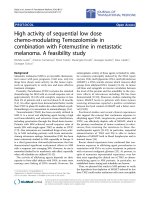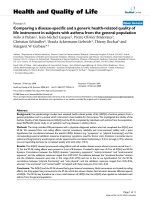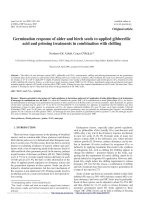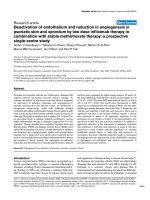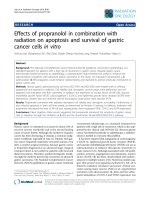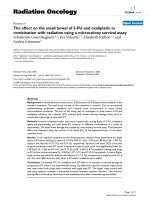Effect of rhizobium and PSB in combination with phosphorus on the enrichment of soil fertility and its effect on yield of green gram (Vigna radiata L.) - Trường Đại học Công nghiệp Thực phẩm Tp. Hồ Chí Minh
Bạn đang xem bản rút gọn của tài liệu. Xem và tải ngay bản đầy đủ của tài liệu tại đây (226.46 KB, 5 trang )
<span class='text_page_counter'>(1)</span><div class='page_container' data-page=1>
<i><b>Int.J.Curr.Microbiol.App.Sci </b></i><b>(2017)</b><i><b> 6</b></i><b>(11): 3648-3652 </b>
3648
<b>Original Research Article </b>
<b>Effect of Rhizobium and PSB in Combination with Phosphorus </b>
<b>on the Enrichment of Soil Fertility and its Effect on Yield of </b>
<b>Green Gram (</b>
<i><b>Vigna radiata</b></i>
<b> L.) </b>
<b>Seerat un Nissa*, Sabiya Bashir, S.A. Dar, Jahangeer A. Baba, </b>
<b>S.A. Hakeem, R.A. Wani, M. Najeeb Mughal and Yusra A. Basu </b>
Dryland (Karewa) Agriculture Research Station, Budgam. Sher-e-Kashmir University of
Agricultural Sciences and Technology of Kashmir, Shalimar, Srinagar, J&K-190025, India
<i>*Corresponding author </i>
<i><b> </b></i> <i><b> </b></i><b>A B S T R A C T </b>
<i><b> </b></i>
<b>Introduction </b>
Legume is widely recognized to be a symbol
of agricultural economy, being a major source
of protein for vegetarian human diet and
improve the soil fertility by their nitrogen
fixing capability. Pulses contain a higher
percentage of quality protein nearly three
times as much as cereals, thus they are a
cheaper source to overcome protein
malnutrition among human being. It is
generally believed that a starter dose of
nitrogen enhances the yield of crop. The
continuous drain upon the nitrogen resources
of the soil and the necessity for higher crop
yield has led to an ever increasing emphasis
on the means of covering the limited supply
of element. As a major single supplier of
biologically fixed nitrogen legume –
Rhizobium symbiosis is at the foremost. In
this regard the use of biological nitrogen
fixation (BNF) technology in grain legumes
can be an alternative to expensive urea
fertilizer, particularly for improving the
production of food legume. Inoculation with
efficient <i>Rhizobium </i> culture to different
legumes is a common agronomic practice for
enhancing pulse production (Bhatt <i>et al.,</i>
2014). Bio-fertilizers such as (PSB) solubilise
insoluble soil phosphates like tri-calcium
<i>International Journal of Current Microbiology and Applied Sciences </i>
<i><b>ISSN: 2319-7706</b></i><b> Volume 6 Number 11 (2017) pp. 3648-3652 </b>
Journal homepage:
The field experiments were conducted during kharif season for the two
consecutive years at the crop research farm, Department of soil science,
RRS Wadura, Sopore, SKUAST-K to study the effect of PSB, Rhizobium
and different levels of phosphorus on growth, nutrient uptake, yield of
green gram (<i>Vigna radiata</i> L) and soil properties. Different levels of
phosphorus (30, 60 and 90 kg/ha) as per treatment and bio-fertilizers
(Rhizobium and PSB) were applied. The combined application of
phosphorus @ 60 kg/ha and Rhizobium resulted in significant higher plant
height (cm), no of branches, no of leaves, no of nodules, available N, P and
K in soil. It gave highest yield (14.39 q/ha).
<b>K e y w o r d s </b>
Rhizobium, PSB,
Soil fertility.
<i><b>Accepted: </b></i>
26 September 2017
<i><b>Available Online: </b></i>
10 November 2017
</div>
<span class='text_page_counter'>(2)</span><div class='page_container' data-page=2>
<i><b>Int.J.Curr.Microbiol.App.Sci </b></i><b>(2017)</b><i><b> 6</b></i><b>(11): 3648-3652 </b>
3649
phosphates and produce plant growth
substances in soil. Among various
bio-fertilizers Rhizobium is of paramount
importance. Rhizobium fixes atmospheric
nitrogen in symbiosis with legumes.
Phosphorus plays a key role in various
physiological processes concerning root and
dry matter production, nodulation and N2
fixation and also in metabolic activities
especially in protein synthesis (Bhatt <i>et al.,</i>
2013) reported same. The study was therefore
undertaken to find out the effect of different
levels of phosphorus and bio-fertilizers on
soil fertility and yield of green gram.
<b>Materials and Methods </b>
A plot experiment was undertaken at
SKUAST K RRS/FOA wadura, Sopore,
during kharif season for the two consecutive
years. Composite soil sample collected from
the field to a depth of 0-15 cm were air dried,
grinded and passed through 2mm sieve for
physical and chemical analysis. The soil used
for cultivation of the crop was clay loam in
texture, with ph of 7.2, O.C 0.6mg/kg and
CEC of 14.7c mol (P-1) kg. The experiments
were laid out in factorial randomized block
design with three replications. The variety
tested was (Shalimar moong-1). Different
levels of phosphorus 30, 60 and 90kg/ha as
per treatments and bio-fertilizers (Rhizobium
and PSB) were applied. Green gram seeds
were inoculated with bio-fertilizers three
hours before sowing. The control plot was
supplied with basal dose of NPK only. In
other plots N & K were supplied as basal but
P was applied @ 30, 60 and 90kg/ha.
<b>Results and Discussion </b>
The data presented in the Table 1a, b and c
clearly shows that the treatments had
significant effect on plant height (cm), No of
branches/plant, No of leaves/plant and No of
nodules/plant. The treatments comprising of
bio-fertilizer Rhizobium with Phosphorus @
60kg/ha showed the best results. The greater
plant height was recorded due to the treatment
(comprising of Rhizobium + phosphorus @
60kg/ha) while the minimum plant height was
associated with the control plot. The increase
in such case may be due to increased cell
division and elongation on one hand and also
the genetic character of variety, thus, lending
further advantage to the height of plant. Our
results confirm the findings of Prasad, S. K. <i>et </i>
<i>al.,</i> 2014). Maximum no. of branches/plant
were obtained with the treatment
(Rhizobium+phosphorus@60kg/ha). This was
also observed by Tiwari <i>et al., </i> (2015)<i>. </i>
Rhizobium inoculation with added
P@60kg/ha recorded the maximum number
of leaves/plant which was found to be
significantly higher than the remaining
treatment combinations. It was also been
reported by Majengo <i>et al.,</i> (2011). The no of
nodule/plant was significantly increased with
the application of Rhizobium and P@60kg/ha
which was also reported by Solaiman <i>et al.,</i>
(2003) and Das <i>et al.,</i> (1997). This might be
due to presence of adequate population to
Rhizobium and equally benefited by
Rhizobium inoculation. The results are in
accordance with the studies conducted by
Prasad, S. K. <i>et al.,</i> (2014).
</div>
<span class='text_page_counter'>(3)</span><div class='page_container' data-page=3>
<i><b>Int.J.Curr.Microbiol.App.Sci </b></i><b>(2017)</b><i><b> 6</b></i><b>(11): 3648-3652 </b>
3650
<b>T1 (a) Effect of phosphorus levels on growth and yield of green gram </b>
Parameters Phosphorus levels
Ist year 2nd year
P0 P30 P60 P90 Sem CD 5% P0 P30 P60 P90 SEM CD 5
%
Plant height
(cm)
57.50 58.73 60.10 60.07 0.33 0.68 57.96 59.20 61.18 61.18 0.30 0.63
No of Branches 24.73 6.50 7.97 8.40 0.23 0.97 7.00 7.77 10.11 10.33 0.20 0.42
No of leaves 6.40 27.81 35.08 34.95 0.95 1.47 25.55 28.78 38.55 38.22 1.22 2.52
Nodules/plant 7.10 8.10 9.20 9.10 0.17 0.35 8.55 13.77 13.89 13.77 0.70 1.45
Seed yield
(q/ha)
10.68 11.89 12.14 12.22 0.17 0.35 10.14 11.40 11.47 11.42 0.22
<b>T1 (b) Effect of bio-fertilizers on growth and yield of green gram </b>
Parameters Phosphorus levels
Ist year 2nd year
B0 BRH BPSB Sem CD 5% B0 BRH BPSB SEM CD 5%
Plant height
(cm)
57.50 60.23 59.80 0.26 0.54 57.96 63.03 59.66 0.28 0.59
No of Branches 6.40 9.55 10.20 0.20 0.41 7.10 11.63 7.44 0.20 0.42
No of leaves 24.73 36.33 25.84 0.82 1.71 25.55 34.57 23.55 1.05 2.18
Nodules/plant 7.10 19.44 7.20 0.15 0.30 16.66 10.00 16.66 0.60 1.25
Seed yield
(q/ha)
10.68 12.62 12.37 0.19 0.40 12.43 12.78 12.43 0.15 0.30
<b>T1 (c) Effect of phosphorus levels and bio-fertilizers on growth and yield of green gram </b>
Parameters Year
Interaction of bio-fertilizers with Phosphorus levels
BRHP30 BRHP60 BRHP90 BPSBP30 BPSBP60 BPSBP90 SEM CD5%
Plant height (cm)
No of Branches
No of leaves
Nodules/plant
Seed yield(qt/ha)
Ist
2nd
Ist
2nd
Ist
2nd
Ist
2nd
Ist
2nd
60.83
63.45
12.07
10.33
41.07
43.67
10.33
21.22
12.95
12.32
62.00
65.44
12.50
12.22
44.15
45.22
10.67
24.89
14.62
14.17
63.03
65.75
12.23
11.22
43.02
45.22
11.10
24.89
14.45
14.15
60.07
63.03
11.47
9.44
28.21
34.66
8.00
18.44
12.48
12.46
60.20
63.49
11.90
11.33
29.51
39.11
9.00
21.22
13.80
13.46
60.60
63.45
11.77
11.11
29.53
39.33
9.33
21.11
13.73
13.45
0.52
0.57
0.39
0.40
1.65
2.11
0.29
NS
0.38
0.29
1.08
1.18
0.81
0.83
3.42
4.37
0.61
NS
0.79
0.11
<b>T2 (a) Effect of phosphorus levels on %organic carbon and available nutrient in soil </b>
Parameters
Phosphorus levels
Ist year 2nd year
P0 P30 P60 P90 Sem CD 5% P0 P30 P60 P90 SEM CD 5%
</div>
<span class='text_page_counter'>(4)</span><div class='page_container' data-page=4>
<i><b>Int.J.Curr.Microbiol.App.Sci </b></i><b>(2017)</b><i><b> 6</b></i><b>(11): 3648-3652 </b>
3651
<b>T2 (b) Effect of bio-fertilizers on %organic carbon and available nutrient in soil </b>
<b>T2 (c) Effect of phosphorus levels and bio-fertilizers on %organic carbon and </b>
available nutrient in soil
Highest yield was observed by the treatment
combination comprising of (Rhizobium +
P2O5 @60kg/ha).Influence of Rhizobium
might have helped in better nodulation and
subsequently helped in increasing availability
of nitrogen, an important nutrient to have
influenced the yield. Vanitha, M<i>., et al.,</i>
(2014) reported the same.
<b>References </b>
Bhatt, P. K., Patel, P. T., Patel, B. T., Raval,
C. H., Vyas, K. G. and Ali, S. 2013.
Productivity, quality, nutrient content
and soil fertility of summer greengram
(<i>Vigna radiata</i>) as influenced by
different levels of vermicompost and
phosphorus with and without PSB.
International Journal of Agricultural
Sciences, 9: 659-662.
Choudhary, R., Singh, K., Manohar, R. S.,
Yadav, A. K., and Sangwan, A.
2015.Response of different sources and
levels of phosphorus on yield, nutrient
uptake and net returns on mungbean
under rainfed condition. Indian Journal
of Agriculture Research, 35: 263-268.
Majengo, C. O., Okalebo, J. R., Lesueur, D.,
Pypers, P., NG’Etich, W., Mutegi, E.,
Mburu, M. W. and Musyoki, M. 2011.
African Crop Science Society
Interaction between nitrogen and
phosphorus microbial inoculants on
soybean production in Bungoma,
Kenya. African Crop Science
Conference Proceedings, 10: 121 – 123.
Pramanik, J. K., Chowdhary, A. K. M. S. H.
and Uddin, F. M. J. 2014.Effect of
Biofertilizer and Weeding on the
Growth Characters and Seed Yield of
Summer Mungbean.J. Environ. Sci. &
Natural Resources, 7: 87–92.
Prasad, S. K., Singh, M. K. and Singh, J.
2014. Response of rhizobium
inoculation and phosphorus levels
onmungbean (<i>Vigna radiata</i> L.) under
guava-based agri-horti system. The
Bioscan, 9: 557-560.
Parameters
Bio-fertilizer Levels
Ist year 2nd year
B0 BRH BPSB Sem CD 5% B0 BRH BPSB SEM CD 5%
%Organic carbon
Available (N)
Available (P)
Available (K)
0.56
198
20
243
0.62
236
21.33
245
0.54
199
23.00
242
0.01
1.31
0.13
0.22
0.02
2.72
0.28
0.46
0.57
196
20.60
253
0.58
227
20.90
256
0.54
192
21.33
258
0.01
1.88
0.08
0.68
0.01
3.90
0.17
1.41
Parameters Year
Interaction of bio-fertilizers with Phosphorus levels
BRHP30 BRHP60 BRHP90 BPSBP30 BPSBP60 BPSBP90 SEM CD5%
</div>
<span class='text_page_counter'>(5)</span><div class='page_container' data-page=5>
<i><b>Int.J.Curr.Microbiol.App.Sci </b></i><b>(2017)</b><i><b> 6</b></i><b>(11): 3648-3652 </b>
3652
Rathour, D. K., Gupta, A. K., Choudhary, R.
R. and Sadhu, A. C. 2015. Effect of
Integrated Phosphorus Management on
Growth, Yield Attributes and Yield of
Summer Green Gram (<i>Vigna radiata</i>
L.).The Bioscan, 10: 05-07
Sharma, M.P. and Khurana, A.S. 1997.
Biofertilizers, Farmer and parliament.
Indian Journal of Agricultural Sciences,
38: 17-18.
Solaiman, Hossain, D,;Haque, M.M.2003.
Response of mung bean varieties to
rhizobium inoculation in respect of
nodulation, nitrogenase activity, dry
matter yield, and nitrogen uptake.
Korean Journal of Crop Science 48:5,
355-360.
Tiwari, S., Kumar, S., Maurya, D. K., Singh,
S. K., Verma, P. K. 2015. Effect of
Phosphorus levels on Growth, Seed
yield, Quality and Nutrient Uptake by
Greengram (<i>Vigna </i> <i>radiate</i> L.).
Enviroment& Ecology, 33: 1731-1733.
Vanitha, M., Radha, S. R. and Vijayakumari,
B. 2014. Herbals and biofertilizer as a
nutrient supplement for improving
biochemical parameters of cluster bean
(<i>Cyamopsis tetragonoloba</i> L. Var.
PNB). Journal of Natural Production
Plant Resources, 4: 29-33.
<b>How to cite this article: </b>
Seerat un Nissa, Sabiya Bashir, S.A. Dar, Jahangeer A. Baba, S.A. Hakeem, R.A. Wani, M.
Najeeb Mughal and Yusra A. Basu. 2017. Effect of Rhizobium and PSB in Combination with
Phosphorus on the Enrichment of Soil Fertility and its Effect on Yield of Green Gram (<i>Vigna </i>
<i>radiata</i> L.). <i>Int.J.Curr.Microbiol.App.Sci.</i> 6(11): 3648-3652.
</div>
<!--links-->
Báo cáo " Development of climate change scenarios for small areas in Vietnam by using the MAGICC/SCENGEN software in combination with statistic correction" docx
- 6
- 655
- 1


